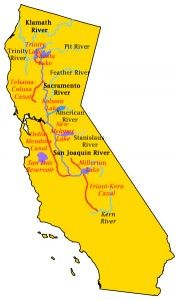An open letter to presidential winner on California water policy
By Wayne Lusvardi
Re: Some California Water Policies to Avoid for the Next President
Dear President (Obama or Romney):
Congratulations on gaining the trust of a majority of the American people in your election victory. The people of California will also place trust in you as the top decision maker on the organization chart for the federal portion of California’s water system, the Central Valley Project.
Most Californians don’t realize that about half of the state’s water system is financed and run by the federal government. As you probably already know, this came about during the Great Depression of the 1930s. California was so broke it couldn’t borrow money with bonds for water projects. So the U.S. government had to take over California’s planned expansion to its water system. This was also the only way at the time to resolve the conflict over water between farmers and growing cities. The Central Valley Project mainly serves farmers. The State Water Project and the Colorado River Aqueduct mostly serves cities.
There are some water policy experts, such as Peter Gleick of the Pacific Institute on Water Policy, who believe: 1) a 21st century water policy should be developed; 2) the spotlight should be on national security issues related to water; 3) the role of the United States in addressing global warming problems should be expanded; and 4) climate change risks should be integrated into all federal water planning and activity.
But it is all gobbledygook to say that water policy needs to form more blue ribbon water commissions composed of elite experts, conduct more studies and hire more consultants like themselves. We had a phrase we used to say when I worked for one of the largest regional water agencies in California: “Government agencies hire consultants to tell them what they already know but want to have validated.”
Contrary to the establishment water experts, here is where federal water policy could be reoriented toward for greater prosperity for all in California and the United States:
Continue the Policies of the Last Century, Not This One
Water experts are calling for a new water policy to replace state and local water governance by: 1) forming blue ribbon water commissions to usurp representative government; 2) “strengthening” the abusive Clean Water Act and Safe Drinking Water Act; 3) socializing water infrastructure financing, contradicting the “user-pays” principle; 4) using the Farm Bill, trade laws, and plumbing and tax codes purportedly to improve water productivity by nationalizing it; and 5) having the Federal government enforce “environmental flows” for all major river systems. These all are nice sounding platitudes that have little to do with the reality of federal and state water policy in California. Such policies literally let our prosperity flow out to the ocean.
As Rep. Tom McClintock, R-Calif., has pointed out, the U.S. Bureau of Reclamation built more than 600 dams and reservoirs in the last century, most more than 50 years ago. The Bureau has built 15 reservoirs in California since 1910, but the last one was in 1979. Lack of new reservoirs is not due to a shortage of potential rainfall. Even in a dry year such as 2001, California had “only” 145 million acre-feet of rainfall and imports. In a typical dry year, that is enough water for 290 million urban households or 145 million acres of farming (Cal State University, Stanislaus).
The problem is capture, storage, and treatment — not drought, not waste by cities or farmers, not global warming, and not necessarily population growth. California only has about six months of excess water storage in its combined state-and-federal water system even in a wet year. What serves as the critical drought buffer for California is water stored in the Sacramento Delta — which once was an inland sea.
Nationalizing state and local water regulations and enforcement is a non-solution. All this will do is socialize the financing of water infrastructure projects and create more artificial jobs programs that do not increase our economy. Such policies will also put a bigger hole in our national debt.
Featherbedding for Duplicate Water Security Not a Priority
Again, there are those water consultants who apparently are targeting the public purse used to prevent potential terrorist threats to our water system. Most of this has already been addressed by the Drinking Water Security Act of 2009 and by the U.S. Environmental Protection Agency’s Water Security Department. This includes Homeland Security Presidential Directives.
Though I am no security expert, I have some familiarity with the subject. I worked at one of California’s largest water agencies for 20 years. I once conducted a mass valuation of probable damage losses to thousands of private properties in the event of breach or failure of its dams or reservoirs by accident or by intentional acts. The valuation was conducted for insurance purposes and included a statistical probability analysis of the risk of dam failure.
First, it is difficult to contaminate large regional water storage reservoirs because most contaminants would likely dissolve (“the solution to pollution is dilution”). How any contaminant would get by urban water treatment plants is another dubious issue.
My understanding is that the greatest water security risk is not at the national, state, or regional level, but at the local level. Thus, any such terrorist acts could likely be used for psychological terrorism. Most law enforcement agencies in California have undergone training in rapid helicopter deployment to protect dams and reservoirs should such any threat arise. I have witnessed such training exercises first hand.
Once again, featherbedding for unneeded consulting contracts for water security should not be given a greater priority than it already has.
Refocus Water Quality on Local, Not Global Issues
Water quality experts are calling for greater U.S. international aid in meeting basic water needs, preventing outbreaks of water-related diseases such as the cholera “perfect storm” in Haiti in 2010, and expanding funding for water scientists and educators.
Certainly, U.S. foreign policy should include aid where possible to ameliorate outbreaks of water-borne diseases in poverty-stricken areas of the world. The cholera epidemic of 2010 in Haiti, which killed 7,500 people, is cited as the reason for greater international water quality funding. However, epidemiologist Dr. Renaud Piarroux of France points out that conventional water quality policy is misguided. The cholera outbreak in Haiti was not, as commonly believed, due to a “perfect storm” of an earthquake and hurricane followed by a hot summer. The source of the cholera probably came from human waste from an encampment of U.N. disaster relief peacekeepers from Nepal that were deployed near a tributary to the Artibonite River.
Contrary to the experts, apparently the outbreak was facilitated by the “environment” — the river environment — that proliferated and spread cholera. The river environment was the killer, not solely the cholera bacteria. This is the reverse of U.S. water-quality policy that focuses on toxic substances to the exclusion of the “environment.” Mistaken U.S. environmental policy is based on the notion that the environment is pure and that man-made substances despoil it. For after all, if you can’t sue a river or shake it down for money by a lawsuit, how can it be at fault?
Like many “environmental” health issues, it is not some toxic substance that is the sole cause. Rather, it is the environment that traps the substance and concentrates it at harmful levels. It is not the environment that needs protection; it is humans who need protection from the environment.
The main principle in toxicology is: “the poison is the dosage.” Pollutants trapped in stagnant urban air basins, natural or man-made chemicals trapped in underground water basins, and asbestos trapped in energy-tight buildings all can lead to health threats. The focus on chemicals and toxic substances, instead of entrapping environments, is misplaced. Nearly every substance is potentially harmful — including pure H20 ingested by humans — if it is concentrated at toxic levels. Thus, both federal and state water quality regulation is misplaced.
The U.S. should re-focus its misplaced water quality policies at home — especially its misguided policies on perchlorate regulation — before exporting such misinformed and potentially harmful policies abroad.
California Has Been Managing Climate Change Forever
Again, water experts are lobbying to “integrate climate change risks into all federal water planning and activity.” They want to: 1) expand efforts to assess the growing impacts of unavoidable climate change on U.S. water resources; 2) improve the “smart management” of both energy and water resources; and 3) integrate strategies for adapting to “climate change” in new construction and operation of existing water systems and reservoirs.
Mr. President, what planet do such experts come from? Certainly not Planet California, where climate change is something we have been trying to manage forever. Certainly, not from the Colorado River Basin, the Southeastern United States — which is experiencing drought — or anywhere else on Planet Earth.
Elitist water policy in California is like a futuristic scene out of the Edgar Rice Burroughs science fiction novel, “A Princess of Mars,” where “water which supplies the farms of Mars is collected in immense underground reservoirs at either pole from the melting ice caps, and pumped through long conduits to the various population centers.”
The above absurd description, based on early belief in “canals” on Mars, sounds like Gov. Jerry Brown’s current proposal to construct massive tunnels under the Sacramento Delta as part of the state’s “climate change” policy. Southern California needs water, but doesn’t need the massive cost of tunnels required to avoid the environmental vetting process.
So-called “climate change” science is a modern version of a religious-like self-fulfilling prophecy. The more you study it, the more you will find it. California’s cyclical dry spells are often used as proof of global warming. The public’s attention is focused on feeling that it is hotter, then they believe it.
California experiences wet monsoon-like rainfall every few years that fills its lakes, reservoirs and the Sacramento Delta. This is followed by dry spells, where we rely on water stored during the wet years. The climate has always changed in California. The water system has been built to convey water from the Delta or the Colorado River to lessen the probability of impact from regional droughts.
Like most of modern day environmentalism, climate change science is just the re-branding of something state and federal water agencies have been doing for more than a century. Climate change science is an industry full of would-be technocratic elites who want to grab funding and take power away from the process of representative government.
We should not place our precious natural resources in the hands of elite technocrats pluming for federal funds for environmental overkill of our economy and representative form of government.
Sincerely,
Wayne Lusvardi
The views expressed are those of the author and not CalWatchDog.com or the Pacific Research Institute.
Related Articles
Crazifornia: Will it be Gov. Brownout?
Feb. 13, 2013 By Laer Pearce On Jan. 31, the strained California electricity grid marked the one year anniversary of
Wide interest in redistricting
This just in: 30,275 people applied to serve on the Citizen’s Redistricting Commission. That’s right — the one with 14




